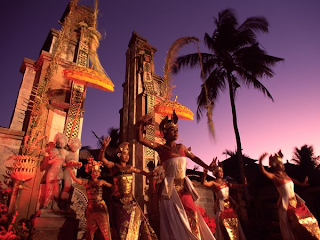here's a first article about travel I'm posting, the source is from nationalgeographic.com, enjoy!
Bora-Bora
Photograph by Tim McKenna
Bora-Bora has so many natural advantages it deserves its long-held reputation as the South Pacific’s loveliest island retreat. “It’s everything a Polynesian island should be—blue lagoon, sand-fringed motus, soaring peaks,” says Lonely Planet founder Tony Wheeler.
Bali
Photograph by Dallas and John Heaton, Aurora
The tiny Hindu island of Bali is one of the world’s few remaining societies where modernity and tradition coexist in harmony. With several hundred dance troupes on the island, dance is at the very center of Balinese life.
Palawan Island, Philippines
Photograph by Christian Kober, Photolibrary
An outrigger canoe glides across crystal waters off Palawan Island in the Philippines. It’s an island of Jules Verne-like vistas, where giant eagles soar, rare seashells litter quiet beaches, and exotic orchids bloom in dark mahogany forests.
Falkland Islands
Photograph by Frans Lanting, National Geographic
Black-browed albatrosses nest by the thousands in the remote Falkland Islands. With few crowds or restrictions, this archipelago comprising 778 islands and islets 300 miles (483 kilometers) off the east coast of Patagonia provide an intimate wildlife experience that offers an alternative to that of the more famous Galápagos.
Palau
Photograph by Andrea Booher, Getty Images
Teeming with exotic marine life and Crayola-colored reefs, the more than 300 islands of Palau, in the Pacific Ocean southwest of Guam, feature some of the world’s best dive sites and the unique foliage-frosted Rock Islands. Palau is also a living World War II museum—WWII wrecks lie submerged just off the Rock Islands.
Thousand Islands, New York
Photograph by Will Van Overbeek, National Geographic
Kids dive in at Thousand Island Park, a historic community on New York’s Wellesley Island. The community was built more than a century ago, during the area’s heyday as a gilded summer retreat. The Thousand Islands archipelago straddles the U.S.-Canada border in the St. Lawrence Seaway.
Easter Island, Chile
Photograph by Jim Richardson, National Geographic
Easter Island is set apart by the wondrous stone statues, called moai, that silently watch over the island’s serene landscape. They were carved from locally quarried tufa—a soft volcanic stone—between 800 and 1722, when a Dutch explorer discovered the island. The average moai is 14 feet (4 meters) tall and weighs ten tons.
Puerto Rico
Photograph by Keiji Iwai, Getty Images
Though beaches like Mar Chiquita Beach draw Boogie-boarders and other watersports lovers, Puerto Rico also offers lots of landlubber entertainment in its main city, San Juan. Roam the largest fort built by the Spanish in the Americas, go antiquing for wooden santos, and sample traditional Puerto Rican dishes like chicken chicharrones.
Sardinia, Italy
Photograph by David Yoder, National Geographic
Soft dusk cloaks pastel-hued Castelsardo, a fortified hilltown on the northwest coast of Sardinia. Still little known by most Americans, Sardinia’s northern coast is a corner of the Mediterranean adored by Italians and in-the-know Europeans.
Lord Howe Island, Australia
Photograph by Tom Till, Getty Images
A scene from the Jurassic age? No, just a typically primeval slice of Lord Howe Island, located off the east coast of Australia. Sydney-based yachtsman Ian Kiernan calls it “Australia’s own Galápagos”; the island stayed totally isolated and—except for a native bat—devoid of mammals from creation until European discovery in 1788.
Quirimbas Archipelago, Mozambique
Photograph by Sergio Ramazzotti, Parallelozero/Aurora
Fishermen fix their boats at low tide on Matemo Island, part of Mozambique’s 32-island Quirimbas Archipelago. The islands and surrounding waters pulse with wildlife: humpback whales, hawksbill turtles, bottlenose dolphins, and a diversity of birds, from storks and spotted eagle-owls to crab plovers and kingfishers.











0 comments:
Post a Comment